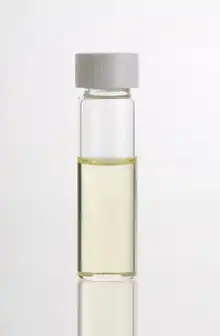Lavender oil

Lavender oil is an essential oil obtained by distillation from the flower spikes of certain species of lavender. There are over 400 types of lavender species worldwide with different scents and qualities. Two forms are distinguished, lavender flower oil, a colorless oil, insoluble in water, having a density of 0.885 g/mL; and lavender spike oil, a distillate from the herb Lavandula latifolia, having density 0.905 g/mL. Like all essential oils, it is not a pure compound; it is a complex mixture of phytochemicals, including linalool and linalyl acetate.
Production
Pure lavender essential oil is produced through steam distillation.[1][2] This generates a greater amount of oil compared to other methods due to reduction of polar compound loss.[3] Harvest of lavender blooms is typically between late June and August.[4] The cut lavender flowers and stems are compacted into a lavender still. A boiler is then used to steam the bottom of the lavender flower filled still at a very low pressure.[1] The lavender flower pockets containing oil are broken from this heating process and a pipe of cold water is run through the center of the still.[1] The hot lavender oil vapor condenses on the cold pipe with the cold water and is collected into a holding tank where it is allowed to settle.[1] Due to polarity and densities of the water and oil, these two will separate in the holding tank whereupon the water is piped out, leaving just lavender essential oil.[5]
Lavender oil is produced around the world, with Bulgaria, France and China leading its production.[6][7]
Uses
Lavender oil has long been used as a perfume, for aromatherapy, and for skin applications.[8][9]: 184–186 Lavender oil is used in massage therapy as a way of inducing relaxation through direct skin contact.[8][10]
Oil of spike lavender was used as a solvent in oil painting, mainly before the use of distilled turpentine became common.[11]
Adverse effects
Lavender oil is poisonous, due to the components linalyl acetate and linalool, and should not be ingested. Symptoms of lavender oil poisoning include blurred vision, difficulty breathing, burning pain in the throat, burns to the eye, confusion, decreased level of consciousness, diarrhea (watery, bloody), stomach pain, vomiting, and rash.[12] In Australia, lavender oil is one of the many essential oils that have been increasingly causing cases of poisoning, mostly of children. In the period 2014-2018 there were 271 reported cases in New South Wales, accounting for 6.1% of essential oil poisoning incidents.[13]
Lavender oil has estrogenic and anti-androgenic effects and there have been reports of its use causing prepubertal gynecomastia (abnormal breast development in children).[14][15] Other potential adverse effects include a sedative effect and contact dermatitis as an allergic reaction, possibly resulting from major lavender oil constituents, camphor, terpinen-4-ol, linalool and linalyl acetate.[16][8]
Environmental impact
A 2018 study by the National Institute of Environmental Health Sciences found four of the constituent chemicals (eucalyptol, 4-terpineol, dipentene and alpha-terpineol) are endocrine disruptors, raising concerns of potential environmental health impact from the oil.[17]
Composition
The exact composition of lavender essential oil varies from species to species but consists primarily of monoterpeneoids and sesquiterpeneoids. Of these linalool and linalyl acetate dominate, with moderate levels of lavandulyl acetate, terpinen-4-ol and lavandulol. 1,8-cineole and camphor are also present in low to moderate qualities. In all lavender oil typically contains many more than 100 compounds, although a great many of these are present at very low concentrations.[18]
The composition of lavender essential oil as obtained by chromatography:
| Family | Composition | Lavande officinale Lavandula angustifolia |
Lavande aspic Lavandula latifolia |
|---|---|---|---|
| Terpenes / Monoterpenols |
Linalool | 28.92 % | 49.47 % |
| α-Terpineol | 0.90% | 1.08% | |
| γ-Terpineol | 0.09% | ||
| Borneol | 1.43% | ||
| Isoborneol | 0.82% | ||
| Terpinen-4-ol | 4.32% | ||
| Nerol | 0.20% | ||
| Lavandulol | 0.78% | ||
| Terpenes / Terpene esters |
 | 32.98 % | |
| Geranyl acetate | 0.60% | ||
| Neryl acetate | 0.32% | ||
| Octene-3-yl acetate | 0.65% | ||
| Lavandulyl acetate | 4.52% | ||
| Terpenes / Monoterpenes |
Myrcene | 0.46% | 0.41% |
| α-Pinene | 0.54% | ||
| β-Pinene | 0.33% | ||
| Camphene | 0.30% | ||
| (E)-β-Ocimene | 3.09% | ||
| (Z)-β-Ocimene | 4.44% | ||
| β-Phellandrene | 0.12% | ||
| Terpenes / Terpenoid oxides |
 Eucalyptol (1,8-cineol) | 25.91 % | |
| Terpenes / Sesquiterpenes |
β-Caryophyllene | 4.62% | 2.10% |
| β-Farnesene | 2.73% | ||
| Germacrene | 0.27% | ||
| α-Humulene | 0.28% | ||
| Ketones |  Camphor |
0.85% | 13.00 % |
| 3-Octanone | 0.72% | ||
 Cryptone | 0.35% |
References
- 1 2 3 4 Lis-Balchin, Maria (August 2002). Lavender: The Genus Lavandula. CRC Press. ISBN 978-0-203-21652-1.
- ↑ Health (U.S.), National Institute of (1919). Digest of Comments on The Pharmacopœia of the United States of America and on the National Formulary for the Calendar Year ... 1905-1922. U.S. Government Printing Office.
- ↑ Masango P (2005-06-01). "Cleaner production of essential oils by steam distillation". Journal of Cleaner Production. 13 (8): 833–839. doi:10.1016/j.jclepro.2004.02.039. ISSN 0959-6526.
- ↑ Simmons, Adelma Grenier (1989). Country wreaths from Caprilands: the legend, lore, and design of traditional herbal wreaths. Rodale Press. ISBN 978-0-87857-792-7.
- ↑ Chanamai R, Horn G, McClements DJ (March 2002). "Influence of oil polarity on droplet growth in oil-in-water emulsions stabilized by a weakly adsorbing biopolymer or a nonionic surfactant". Journal of Colloid and Interface Science. 247 (1): 167–76. Bibcode:2002JCIS..247..167C. doi:10.1006/jcis.2001.8110. PMID 16290453.
- ↑ Mihala, Lorelei (2020-07-30). "Bulgarian lavender: The sweet smell of success". BBC News. Retrieved 2020-08-03.
- ↑ Giray, Handan (November 2018). "An Analysis of World Lavender Oil Markets and Lessons for Turkey". Journal of Essential Oil-bearing Plants. 21 (6): 1612–1623. doi:10.1080/0972060X.2019.1574612. S2CID 107300743.
- 1 2 3 Sarkic A, Stappen I (12 January 2018). "Essential oils and their single compounds in cosmetics: A critical review". Cosmetics. 5 (1): 11. doi:10.3390/cosmetics5010011. ISSN 2079-9284.
- ↑ Groom N (1997). The New Perfume Handbook (2nd ed.). Blackie Academic & Professional. ISBN 978-0-7514-0403-6.
- ↑ Fismer KL, Pilkington K (2012). "Lavender and sleep: A systematic review of the evidence". European Journal of Integrative Medicine. 4 (4): e436–e447. doi:10.1016/j.eujim.2012.08.001.
- ↑ Ward GW, ed. (2008). The Grove encyclopedia of materials and techniques in art. Oxford University Press. pp. 605–606. ISBN 978-0-19-531391-8.
- ↑ "Lavender oil". MedlinePlus. U.S. National Library of Medicine, U.S. Department of Health and Human Services. Retrieved January 9, 2020.
Poisonous Ingredient: It is mainly the linalyl acetate and linalool in lavender oil that are poisonous.
- ↑ Lee KA, Harnett JE, Cairns R (November 2019). "Essential oil exposures in Australia: analysis of cases reported to the NSW Poisons Information Centre". The Medical Journal of Australia. 212 (3): 132–133. doi:10.5694/mja2.50403. PMID 31709543. Lay summary.
{{cite journal}}: Cite uses deprecated parameter|lay-url=(help) - ↑ Poon SW, Siu KK, Tsang AM (October 2020). "Isoniazid-induced gynaecomastia: report of a paediatric case and review of literature". BMC Endocr Disord (Review). 20 (1): 160. doi:10.1186/s12902-020-00639-9. PMC 7590456. PMID 33109161.
- ↑ Restrepo R, Cervantes LF, Swirsky AM, Diaz A (October 2021). "Breast development in pediatric patients from birth to puberty: physiology, pathology and imaging correlation". Pediatr Radiol (Review). 51 (11): 1959–1969. doi:10.1007/s00247-021-05099-4. PMID 34236480.
- ↑ Elshafie HS, Camele I (5 November 2017). "An Overview of the Biological Effects of Some Mediterranean Essential Oils on Human Health". BioMed Research International. 2017: 9268468. doi:10.1155/2017/9268468. PMC 5694587. PMID 29230418.
- ↑ "Chemicals in lavender and tea tree oil appear to be hormone disruptors". Endocrine Society. 19 March 2018.
- ↑ Shellie R, Mondello L, Marriott P, Dugo G (September 2002). "Characterisation of lavender essential oils by using gas chromatography-mass spectrometry with correlation of linear retention indices and comparison with comprehensive two-dimensional gas chromatography". Journal of Chromatography A. 970 (1–2): 225–34. doi:10.1016/S0021-9673(02)00653-2. PMID 12350096.